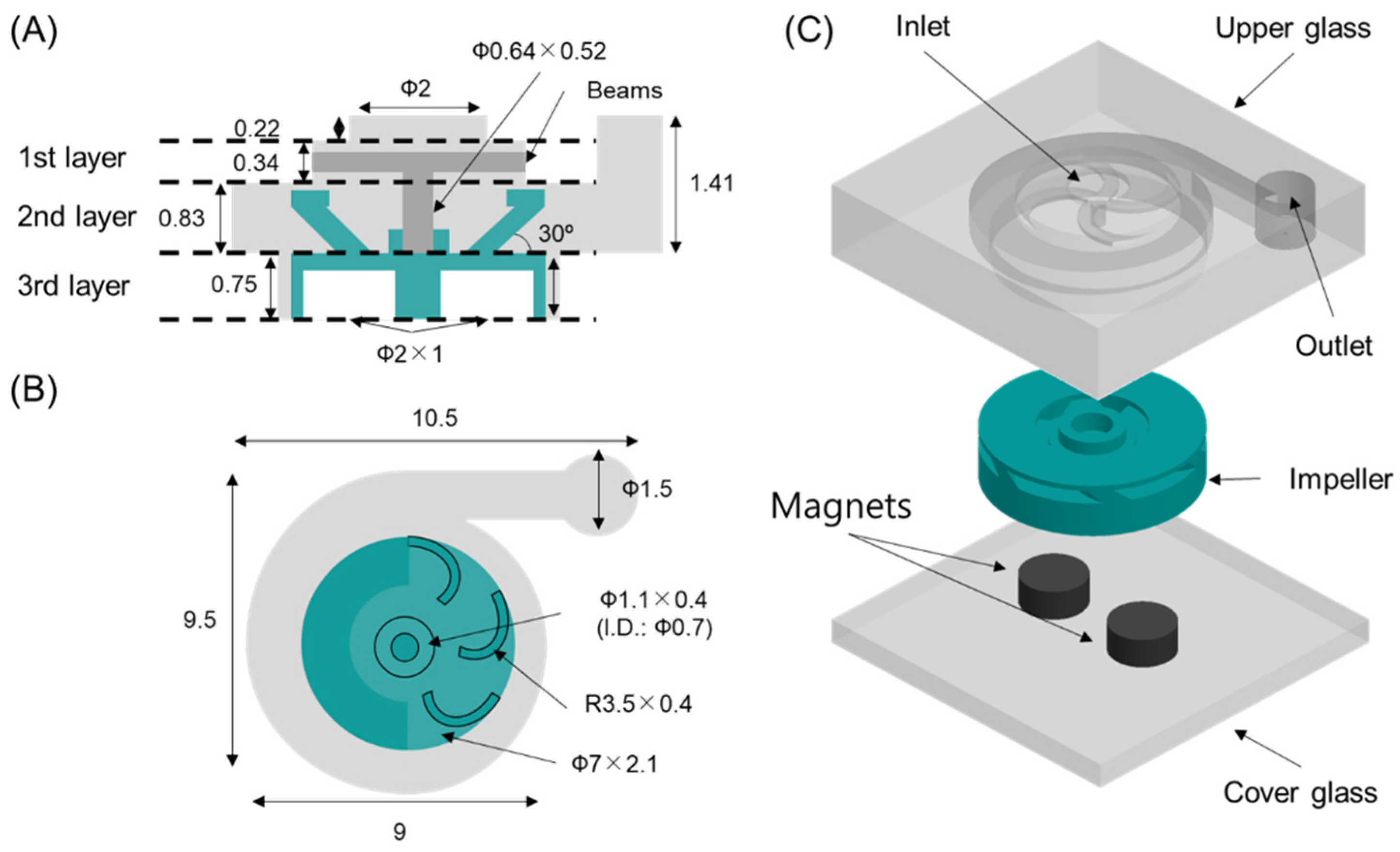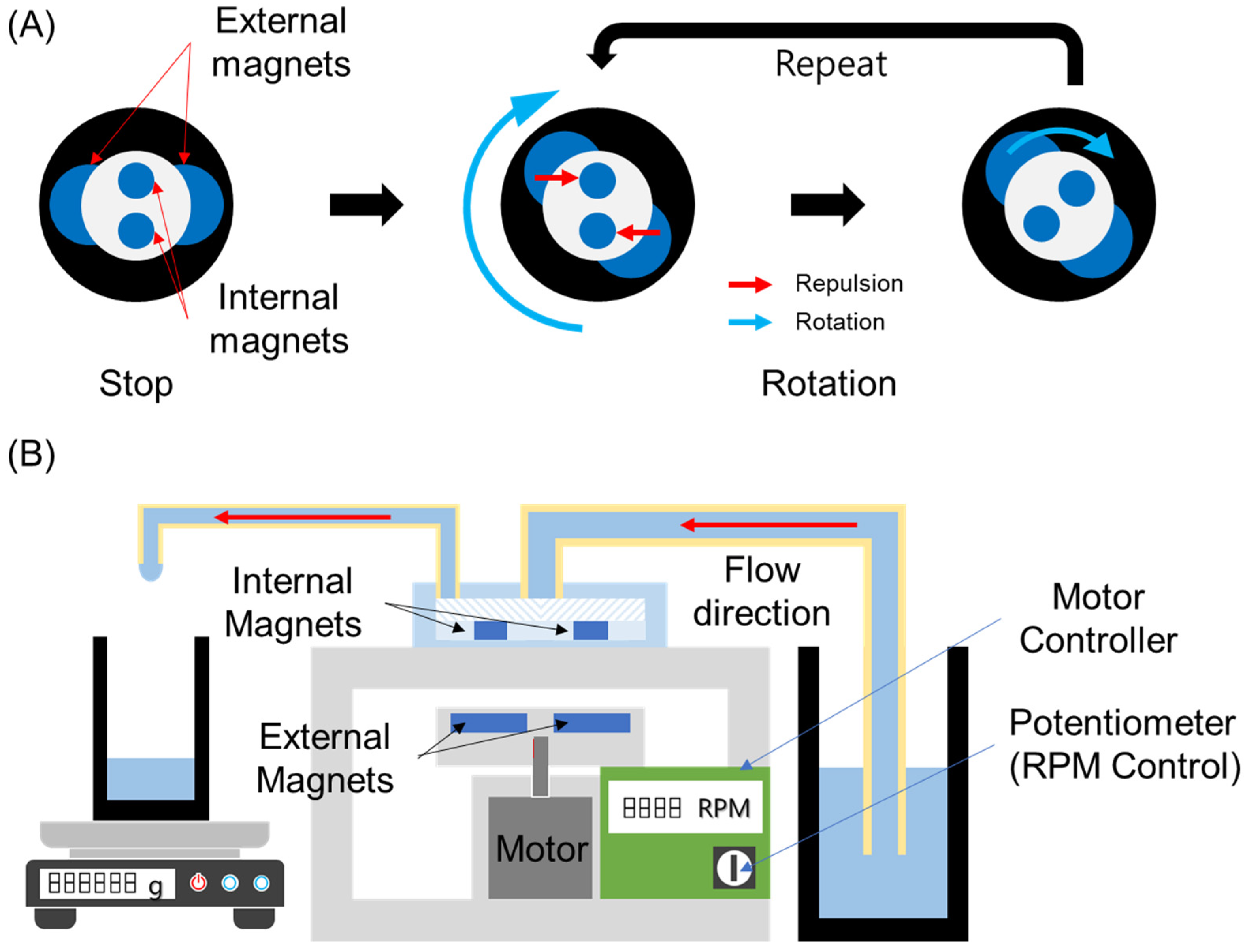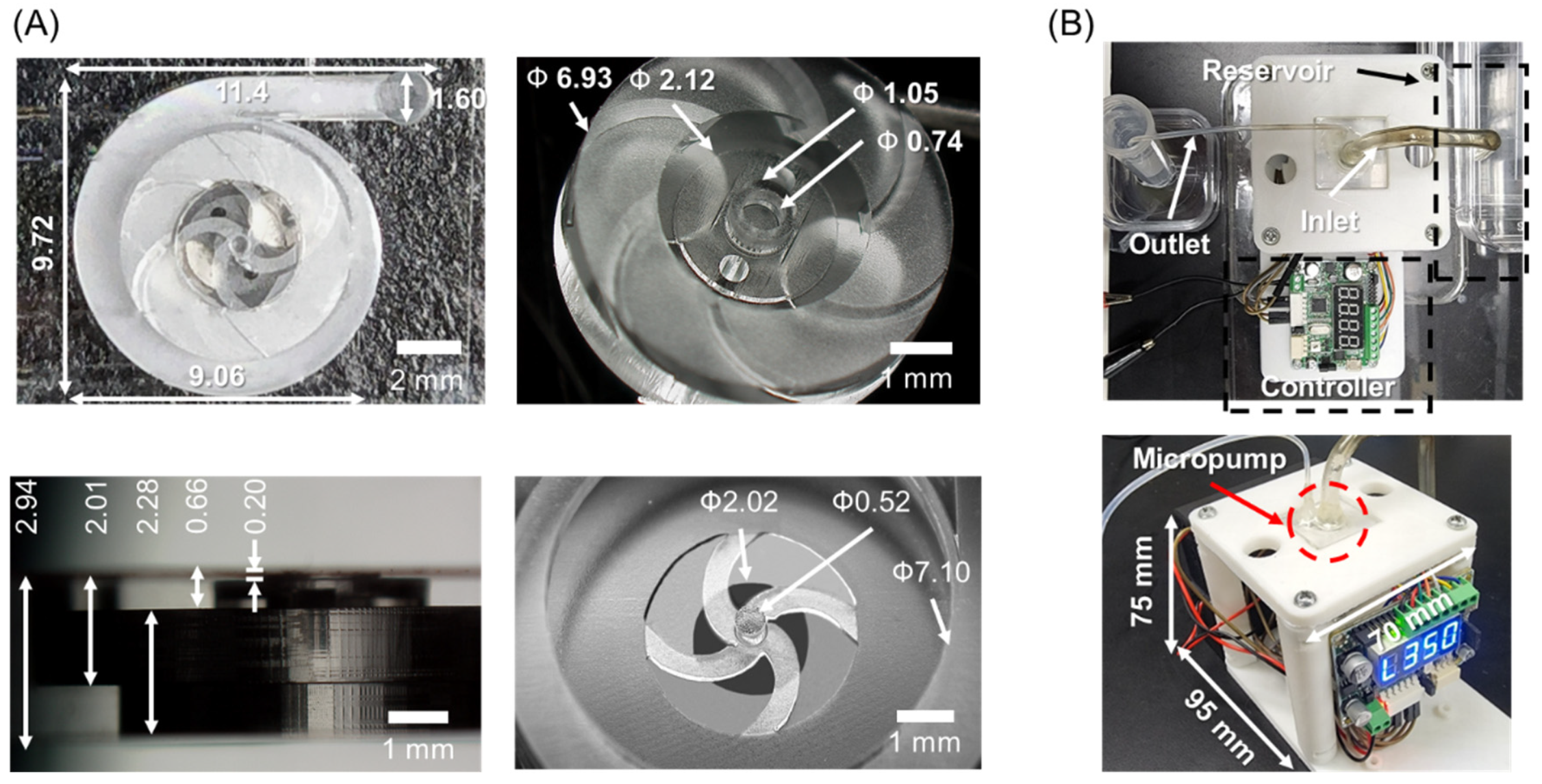A 3D Miniaturized Glass Magnetic-Active Centrifugal Micropump Fabricated by SLE Process and Laser Welding
Abstract
:1. Introduction
2. Materials and Methods
2.1. Design of a 3D Glass Magnetic-Active Centrifugal Micropump for Microfluidic Applications
2.2. Fabrication Methods
2.3. Operation Principle and Performance Evaluation of Micropump
3. Results and Discussion
3.1. Fabrication Results
3.2. Performance Evaluation of 3D Glass Magnetic-Active Centrifugal Micropump
3.3. Rotation Speed Estimation of 3D Glass Magnetic-Active Centrifugal Micropump
3.4. Comparison with Other Miniaturized Pumps
4. Conclusions
Supplementary Materials
Author Contributions
Funding
Data Availability Statement
Acknowledgments
Conflicts of Interest
References
- Jia, Y.; Sun, H.; Li, X.; Sun, D.; Hu, T.; Xiang, N.; Ni, Z. Paper-Based Graphene Oxide Biosensor Coupled with Smartphone for the Quantification of Glucose in Oral Fluid. Biomed. Microdevices 2018, 20, 89. [Google Scholar] [CrossRef]
- Zhang, Z.; Azizi, M.; Lee, M.; Davidowsky, P.; Lawrence, P.; Abbaspourrad, A. A Versatile, Cost-Effective, and Flexible Wearable Biosensor for in Situ and Ex Situ Sweat Analysis, and Personalized Nutrition Assessment. Lab Chip 2019, 19, 3448–3460. [Google Scholar] [CrossRef]
- Prattis, I.; Hui, E.; Gubeljak, P.; Kaminski Schierle, G.S.; Lombardo, A.; Occhipinti, L.G. Graphene for Biosensing Applications in Point-of-Care Testing. Trends Biotechnol. 2021, 39, 1065–1077. [Google Scholar] [CrossRef]
- Laser, D.J.; Santiago, J.G. A Review of Micropumps. J. Micromech. Microeng. 2004, 14, R35–R64. [Google Scholar] [CrossRef]
- Burger, R.; Kurzbuch, D.; Gorkin, R.; Kijanka, G.; Glynn, M.; McDonagh, C.; Ducrée, J. An Integrated Centrifugo-Opto-Microfluidic Platform for Arraying, Analysis, Identification and Manipulation of Individual Cells. Lab Chip 2015, 15, 378–381. [Google Scholar] [CrossRef]
- Arabghahestani, M.; Karimian, S.M.H. Molecular Dynamics Simulation of Rotating Carbon Nanotube in Uniform Liquid Argon Flow. J. Mol. Liq. 2017, 225, 357–364. [Google Scholar] [CrossRef]
- Shen, F.; Li, X.J.; Li, P.C.H. Study of Flow Behaviors on Single-Cell Manipulation and Shear Stress Reduction in Microfluidic Chips Using Computational Fluid Dynamics Simulations. Biomicrofluidics 2014, 8, 014109. [Google Scholar] [CrossRef]
- Al-Halhouli, A.; Al-Shishani, G.; Albagdady, A.; Al-Faqheri, W. New Generation of Spinning Systems for Robust Active Mixing on Microfluidic CDs: Oil/Water Emulsion as an Evaluation Test. RSC Adv. 2018, 8, 26619–26625. [Google Scholar] [CrossRef]
- Park, J.; Park, J.K. Finger-Actuated Microfluidic Device for the Blood Cross-Matching Test. Lab Chip 2018, 18, 1215–1222. [Google Scholar] [CrossRef]
- Li, W.; Chen, T.; Chen, Z.; Fei, P.; Yu, Z.; Pang, Y.; Huang, Y. Squeeze-Chip: A Finger-Controlled Microfluidic Flow Network Device and Its Application to Biochemical Assays. Lab A Chip 2012, 12, 1587–1590. [Google Scholar] [CrossRef]
- Komeya, M.; Hayashi, K.; Nakamura, H.; Yamanaka, H.; Sanjo, H.; Kojima, K.; Sato, T.; Yao, M.; Kimura, H.; Fujii, T.; et al. Pumpless Microfluidic System Driven by Hydrostatic Pressure Induces and Maintains Mouse Spermatogenesis in Vitro. Sci. Rep. 2017, 7, 15459. [Google Scholar] [CrossRef] [PubMed]
- Olanrewaju, A.; Beaugrand, M.; Yafia, M.; Juncker, D. Capillary Microfluidics in Microchannels: From Microfluidic Networks to Capillaric Circuits. Lab Chip 2018, 18, 2323–2347. [Google Scholar] [CrossRef] [PubMed]
- Soenksen, L.R.; Kassis, T.; Noh, M.; Griffith, L.G.; Trumper, D.L. Closed-Loop Feedback Control for Microfluidic Systems through Automated Capacitive Fluid Height Sensing. Lab Chip 2018, 18, 902–914. [Google Scholar] [CrossRef]
- Derjaguin, B.v.; Dukhin, S.S.; Koptelova, M.M. Capillary Osmosis through Porous Partitions and Properties of Boundary Layers of Solutions. J. Colloid Interface Sci. 1972, 38, 584–595. [Google Scholar] [CrossRef]
- Lee, C.; Cottin-Bizonne, C.; Biance, A.L.; Joseph, P.; Bocquet, L.; Ybert, C. Osmotic Flow through Fully Permeable Nanochannels. Phys. Rev. Lett. 2014, 112, 244501. [Google Scholar] [CrossRef]
- Yoshimura, K.; Otsuka, Y.; Mao, Z.; Cacucciolo, V.; Okutaki, T.; Yamagishi, H.; Hashimura, S.; Hosoya, N.; Sato, T.; Yamanishi, Y.; et al. Autonomous Oil Flow Generated by Self-Oscillating Polymer Gels. Sci. Rep. 2020, 10, 12834. [Google Scholar] [CrossRef]
- Aishan, Y.; Yalikun, Y.; Shen, Y.; Yuan, Y.; Amaya, S.; Okutaki, T.; Osaki, A.; Maeda, S.; Tanaka, Y. A Chemical Micropump Actuated by Self-Oscillating Polymer Gel. Sens. Actuators B Chem. 2021, 337, 129769. [Google Scholar] [CrossRef]
- Ozcelik, A.; Aslan, Z. A Practical Microfluidic Pump Enabled by Acoustofluidics and 3D Printing. Microfluid. Nanofluidics 2021, 25, 5. [Google Scholar] [CrossRef]
- Wang, C.; Kazoe, Y.; Morikawa, K.; Shimizu, H.; Pihosh, Y.; Mawatari, K.; Kitamori, T. Micro Heat Pipe Device Utilizing Extended Nanofluidics. RSC Adv. 2017, 7, 50591–50597. [Google Scholar] [CrossRef]
- Wang, X.; Jiang, H.; Chen, Y.; Qiao, X.; Dong, L. Microblower-Based Microfluidic Pump. Sens. Actuators A Phys. 2017, 253, 27–34. [Google Scholar] [CrossRef]
- Park, J.; Park, J.K. Integrated Microfluidic Pumps and Valves Operated by Finger Actuation. Lab Chip 2019, 19, 2973–2977. [Google Scholar] [CrossRef] [PubMed]
- Al-Halhouli, A.; El Far, B.; Albagdady, A.; Al-Faqheri, W. Development of Active Centrifugal Pump for Microfluidic CD Platforms. Micromachines 2020, 11, 140. [Google Scholar] [CrossRef] [PubMed]
- Joswig, L.; Vellekoop, M.J.; Lucklum, F. Miniature 3D-Printed Centrifugal Pump with Non-Contact Electromagnetic Actuation. Micromachines 2019, 10, 631. [Google Scholar] [CrossRef] [PubMed]
- Mao, Z.-b.; Asai, Y.; Wiranata, A.; Kong, D.-q.; Man, J. Eccentric Actuator Driven by Stacked Electrohydrodynamic Pumps. J. Zhejiang Univ. Sci. A 2022, 23, 329–334. [Google Scholar] [CrossRef]
- Berthier, E.; Young, E.W.K.; Beebe, D. Engineers Are from PDMS-Land, Biologists Are from Polystyrenia. Lab Chip 2012, 12, 1224–1237. [Google Scholar] [CrossRef]
- Halldorsson, S.; Lucumi, E.; Gómez-Sjöberg, R.; Fleming, R.M.T. Advantages and Challenges of Microfluidic Cell Culture in Polydimethylsiloxane Devices. Biosens. Bioelectron. 2015, 63, 218–231. [Google Scholar] [CrossRef]
- Osellame, R.; Hoekstra, H.J.W.M.; Cerullo, G.; Pollnau, M. Femtosecond Laser Microstructuring: An Enabling Tool for Optofluidic Lab-on-Chips. Laser Photonics Rev. 2011, 5, 442–463. [Google Scholar] [CrossRef]
- Marcinkevicius, A.; Juodkazis, S.; Watanabe, M.; Miwa, M.; Matsuo, S.; Misawa, H.; Nishii, J. Femtosecond Laser-Assisted Three-Dimensional Microfabrication in Silica. Opt. Lett. 2001, 26, 277–279. [Google Scholar] [CrossRef]
- Sugioka, K.; Xu, J.; Wu, D.; Hanada, Y.; Wang, Z.; Cheng, Y.; Midorikawa, K. Femtosecond Laser 3D Micromachining: A Powerful Tool for the Fabrication of Microfluidic, Optofluidic, and Electrofluidic Devices Based on Glass. Lab Chip 2014, 14, 3447–3458. [Google Scholar] [CrossRef]
- Sugioka, K.; Cheng, Y. Femtosecond Laser 3D Micromachining for Microfluidic and Optofluidic Applications; Springer: London, UK, 2013; ISBN 9781447155409. [Google Scholar]
- Wang, B.X.; Qi, J.Y.; Lu, Y.M.; Zheng, J.X.; Xu, Y.; Liu, X.Q. Rapid Fabrication of Smooth Micro-Optical Components on Glass by Etching-Assisted Femtosecond Laser Modification. Materials 2022, 15, 678. [Google Scholar] [CrossRef]
- Liu, Z.; Xu, J.; Lin, Z.; Qi, J.; Li, X.; Zhang, A.; Lin, J.; Chen, J.; Fang, Z.; Song, Y.; et al. Fabrication of Single-Mode Circular Optofluidic Waveguides in Fused Silica Using Femtosecond Laser Microfabrication. Opt. Laser Technol. 2021, 141, 107118. [Google Scholar] [CrossRef]
- Hermans, M.; Gottmann, J.; Riedel, F. Selective, Laser-Induced Etching of Fused Silica at High Scan-Speeds Using KOH. J. Laser Micro Nanoeng. 2014, 9, 126–131. [Google Scholar] [CrossRef]
- Hnatovsky, C.; Taylor, R.S.; Simova, E.; Rajeev, P.P.; Rayner, D.M.; Bhardwaj, V.R.; Corkum, P.B. Fabrication of Microchannels in Glass Using Focused Femtosecond Laser Radiation and Selective Chemical Etching. Appl. Phys. A Mater. Sci. Processing 2006, 84, 47–61. [Google Scholar] [CrossRef]
- Hnatovsky, C.; Taylor, R.S.; Simova, E.; Bhardwaj, V.R.; Rayner, D.M.; Corkum, P.B. Polarization-Selective Etching in Femtosecond Laser-Assisted Microfluidic Channel Fabrication in Fused Silica. Opt. Lett. 2005, 30, 1867. [Google Scholar] [CrossRef] [PubMed]
- Kim, S.; Kim, J.; Joung, Y.H.; Ahn, S.; Choi, J.; Koo, C. Optimization of Selective Laser-Induced Etching (SLE) for Fabrication of 3D Glass Microfluidic Device with Multi-Layer Micro Channels. Micro Nano Syst. Lett. 2019, 7, 15. [Google Scholar] [CrossRef]
- Kim, S.; Kim, J.; Joung, Y.H.; Ahn, S.; Park, C.; Choi, J.; Koo, C. Monolithic 3D Micromixer with an Impeller for Glass Microfluidic Systems. Lab A Chip 2020, 20, 4474–4485. [Google Scholar] [CrossRef]
- Kim, J.; Kim, S.I., II; Joung, Y.H.; Choi, J.; Koo, C. Two-Step Hybrid Process of Movable Part inside Glass Substrate Using Ultrafast Laser. Micro Nano Syst. Lett. 2021, 9, 16. [Google Scholar] [CrossRef]
- Tamaki, T.; Watanabe, W.; Nishii, J.; Itoh, K. Welding of Transparent Materials Using Femtosecond Laser Pulses. Jpn. J. Appl. Phys. Part 2 Lett. 2005, 44, L687–L689. [Google Scholar] [CrossRef]
- Cvecek, K.; Miyamoto, I.; Strauss, J.; Wolf, M.; Frick, T.; Schmidt, M. Sample Preparation Method for Glass Welding by Ultrashort Laser Pulses Yields Higher Seam Strength. Appl. Opt. 2011, 50, 1941–1944. [Google Scholar] [CrossRef]
- Tan, H.; Duan, J. Welding of Glasses in Optical and Partial-Optical Contact via Focal Position Adjustment of Femtosecond-Laser Pulses at Moderately High Repetition Rate. Appl. Phys. A Mater. Sci. Process. 2017, 123, 481. [Google Scholar] [CrossRef]
- Kim, S.; Kim, J.; Joung, Y.H.; Choi, J.; Koo, C. Bonding Strength of a Glass Microfluidic Device Fabricated by Femtosecond Laser Micromachining and Direct Welding. Micromachines 2018, 9, 639. [Google Scholar] [CrossRef] [PubMed]







| Pump Type | Q (mL∙min−1) | Pump Size (mm3) | Estimated Peripherals Size (mm) | Ref. |
|---|---|---|---|---|
| Acoustofluidics (3D-printed) | 0.002–0.012 | 55 × 22 × 3 | (1) Power supply (255 × 145 × 265) (2) Audio amplifier (Not shown) | [18] |
| Microblower-based | 1 × 10−10– 128 | 20 × 20 × 1.85 | (1) Reservoir (90 × 55 × 9) (2) Driver (30 × 40 × 5) (3) DC power supply (not shown) | [20] |
| Centrifugal (in CD) | 0.84–10 | 25 (D) × 10 (estimated) | (1) Microfluidic CD with another motor (120 × 120 × 150) (2) Computer | [22] |
| Centrifugal (3D-printed) | 103–124 | 28 × 30 × 24 | (1) Control board (50 × 50 × 20) (2) DC power supply (213 × 89 × 348) | [23] |
| Centrifugal (SLE) | 0.54–7.88 | 25 × 25 × 4 | (1) Motor control system including a battery (95 × 70 × 75) | this work |
Publisher’s Note: MDPI stays neutral with regard to jurisdictional claims in published maps and institutional affiliations. |
© 2022 by the authors. Licensee MDPI, Basel, Switzerland. This article is an open access article distributed under the terms and conditions of the Creative Commons Attribution (CC BY) license (https://creativecommons.org/licenses/by/4.0/).
Share and Cite
Kim, J.; Kim, S.; Choi, J.; Koo, C. A 3D Miniaturized Glass Magnetic-Active Centrifugal Micropump Fabricated by SLE Process and Laser Welding. Micromachines 2022, 13, 1331. https://doi.org/10.3390/mi13081331
Kim J, Kim S, Choi J, Koo C. A 3D Miniaturized Glass Magnetic-Active Centrifugal Micropump Fabricated by SLE Process and Laser Welding. Micromachines. 2022; 13(8):1331. https://doi.org/10.3390/mi13081331
Chicago/Turabian StyleKim, Jeongtae, Sungil Kim, Jiyeon Choi, and Chiwan Koo. 2022. "A 3D Miniaturized Glass Magnetic-Active Centrifugal Micropump Fabricated by SLE Process and Laser Welding" Micromachines 13, no. 8: 1331. https://doi.org/10.3390/mi13081331
APA StyleKim, J., Kim, S., Choi, J., & Koo, C. (2022). A 3D Miniaturized Glass Magnetic-Active Centrifugal Micropump Fabricated by SLE Process and Laser Welding. Micromachines, 13(8), 1331. https://doi.org/10.3390/mi13081331






